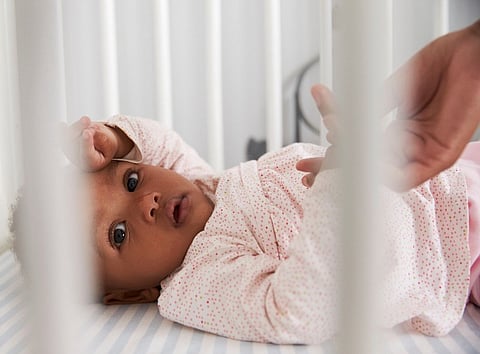MONDAY, March 25, 2024 (HealthDay News) -- Babies who die unexpectedly in their sleep often are subjected to many hazards that could have contributed to their deaths, a new study reports.
Multiple unsafe sleep practices are at play in three-quarters (76%) of Sudden Unexpected Infant Deaths (SUID), according to a new study in the journal Pediatrics.
These include sharing a bed with someone else, sleeping with soft items that can suffocate, sleeping on their bellies or sides, and sleeping outside a crib, results show.
“The large number of hazardous sleep practices for both infants who were sharing a sleep surface and sleeping alone at the time of death is alarming,” senior researcher Dr. Fern Hauck, a safe-sleep expert at the University of Virginia School of Medicine, said in a news release.
For the study, researchers analyzed nearly 7,600 SUID cases that occurred in the U.S. between 2011 and 2020.
About 3 in 5 (60%) of SUID cases involved an infant sharing a sleep surface when they died, researchers found.
This practice is highly discouraged because an adult or even another child can unintentionally roll over and suffocate the baby, researchers said.
Babies who died while sharing a sleep surface often were also sleeping in an adult bed (76%), sleeping with soft bedding in the environment (68%), and sleeping on their bellies or sides (47%).
“These are known risk factors for SUID, and tells us that we need to do a better job of working with families to increase acceptance of the recommendations to create safer sleep spaces for their infants,” Hauck said.
Sleep experts recommend that babies sleep alone on their backs in a crib covered solely with a fitted sheet.
Any soft toys, bumpers, wedges or blankets can increase risk of suffocation, and babies who sleep on their backs are much less likely to die of Sudden Infant Death Syndrome (SIDS), according to the U.S. Centers for Disease Control and Prevention.
SIDS is the term used for infant deaths without any apparent explanation. SUID includes cases of SIDS, as well as deaths explained by reasons like accidental strangulation or suffocation in bed.
Babies who died while sleeping alone most often were on their bellies or sides (62%) and had soft bedding present (74%), results show. About 52% were in a crib and 22% in an adult bed.
The results show that extra effort needs to be taken to explain safe sleep practices to new parents before they’ve left the hospital, and then to follow up with them at every opportunity, Hauck said.
“SUID deaths in the U.S. are still higher than in most other countries, and this is unacceptable,” Hauck said. “Clinicians and others caring for infants need to have thoughtful conversations with families at risk to understand the barriers to following safe-sleep guidelines and find ways to work together to overcome them.”
Hospitals also can direct struggling families to resources that can help them afford a crib or bassinet for their baby, researchers added.
More information
The U.S. Centers for Disease Control and Prevention has more about helping babies sleep safely.
SOURCE: University of Virginia, news release, March 21, 2024


